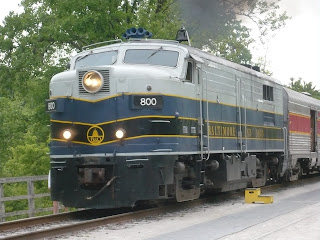We bought Discovery Passes so we could do everything. We wandered around the edge for a bit, looked at the American Rapids and American Falls. They're doing some construction on Lumi Island, so you can't get down to where you're right on top of the falls. There's mist everywhere!
They give you a bright yellow rain poncho to wear. It might not keep you dry, but if you fall the other tourists will be able to see it and take lots of pictures for the evening news. There are also cheap sandals so you don't slip. Your own shoes go in a plastic bag that might keep them dry.

You go down in the elevator so you can climb up again. The Cave of the Winds has been gone since 1924, so the name is obsolete. Instead of a trail behind Bridal Veil Falls, there are a series of stairs and decks that take you in front of the waterfall.
The rocks between the river and the walkway are covered with nesting Ring-billed Gulls. It's like being in the middle of a Discovery Channel show. However, I now understand why seagulls aren't afraid to be around people. They hatch right next to the path, with hundreds of people gaping at them all day long. With that much attention, any initial shyness has been negated.
The decks are spread all over the place, high, low, beside the falls, in front of the falls (American Fall on the left; Luna Fall on the right). The highest deck is called the Hurricane Deck, with wind speeds generated by the power of the water up to 65 mph. That's where the poncho whips and rips--and you get drenched. We didn't go quite that high, but it was still pretty impressive.
We took the trolley to Terrapin Point to see Horseshoe Falls from the top. Check out the water action as it's getting ready to go over.
Next we headed over to the Observation Tower to see the falls from above.
Time for the Maid of the Mist tour. We got blue ponchos that were even thinner than the yellow ones.
.JPG)
.JPG) The boat takes you to the base of American and Horseshoe Falls. You'd need a waterproof camera to really get good pictures! The water was blowing so hard into my face when we got close to Horseshoe Falls, I could barely keep my eyes open! And the noise was unbelievable right there...
The boat takes you to the base of American and Horseshoe Falls. You'd need a waterproof camera to really get good pictures! The water was blowing so hard into my face when we got close to Horseshoe Falls, I could barely keep my eyes open! And the noise was unbelievable right there...
We picked the absolutely perfect day to go. We got there before peak tourist season in June, so no crowds, no lines, no waiting. It was a warm and sunny day, so the sky and water were blue, and we dried off quickly. The wisteria and locust trees were in bloom, so the whole park smelled wonderful.
For lots more pictures of the waterfalls: Niagara Falls State Park (Let me know which one you like best.)

.JPG)
















.JPG)













.JPG)













.JPG)

.JPG)
